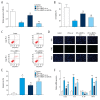Silencing of Long Non-Coding RNA (lncRNA) Nuclear Paraspeckle Assembly Transcript 1 (NEAT1) Protects PC-12 Cells from LPS-Induced Injury via Targeting miR-29a
- PMID: 32776916
- PMCID: PMC7439599
- DOI: 10.12659/MSM.923914
Silencing of Long Non-Coding RNA (lncRNA) Nuclear Paraspeckle Assembly Transcript 1 (NEAT1) Protects PC-12 Cells from LPS-Induced Injury via Targeting miR-29a
Abstract
BACKGROUND Spinal cord injury (SCI) is a debilitating neuropathological condition that significantly affects the quality of life. The present study is basic research examining the underlying mechanisms of NEAT1 and miR-29a in regulating LPS-induced PC-12 cell injury. MATERIAL AND METHODS The model of cell injury was induced by the treatment of PC-12 cells with LPS. The expressions of NEAT1, miR-29a, and inflammatory cytokines were measured by real-time quantitative polymerase chain reactions (RT-qPCR). Cell proliferation and apoptosis were evaluated by CCK-8 and flow cytometry, respectively. Finally, the target between miR-29a and NEAT1 as well as miR-29a and BCL2L11 was investigated by luciferase and RNA pull-down assays. RESULTS Knockdown of NEAT1 can inhibit inflammatory cytokine expression and PC-12 cell apoptosis and promote PC-12 cell proliferation by targeting miR-29a. However, the variation caused by NEAT1 knockdown can be reversed by the silencing of miR-29a and the overexpression of BCL2L11, which is the direct target gene of miR-29a. CONCLUSIONS High NEAT1 levels can increase LPS-induced injury in PC-12 cells through the miR-29a/BCL2L11 pathway. lncRNA NEAT1 may, therefore, be a promising target for SCI treatment.
Figures






References
-
- Cadel L, Everall AC, Packer TL, et al. Exploring the perspectives on medication self-management among persons with spinal cord injury/dysfunction and providers. Res Social Adm Pharm. 2020 [Online ahead of print] - PubMed
-
- James ND, McMahon SB, Field-Fote EC, Bradbury EJ. Neuromodulation in the restoration of function after spinal cord injury. Lancet Neurol. 2018;17:905–17. - PubMed
-
- de Araujo A, Ribeiro F, Massetti T, et al. Effectiveness of anodal transcranial direct current stimulation to improve muscle strength and motor functionality after incomplete spinal cord injury: a systematic review and meta-analysis. Spinal Cord. 2020 [Online ahead of print] - PubMed
-
- Ong B, Wilson JR, Henzel MK. Management of the patient with chronic spinal cord injury. Med Clin North Am. 2020;104:263–78. - PubMed
MeSH terms
Substances
LinkOut - more resources
Full Text Sources

